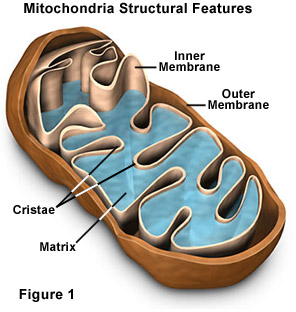Ever wondered how your body produces energy? Really… have you thought about where you get the energy to move, think, sprint, run, and jump comes from?
A lot of people will initially say ‘food‘, and you’d be right in saying that. However, there are hundreds of complex processes that take place to the foods we eat before it can become usable ‘energy‘.
This is where the mitochondria come in. The mitochondria is a cell that takes the foods we eat (which are stored in the liver and muscles, or as fat) and converts them into ATP – Adenosine Triphosphate. The mitochondria acts as a processor, filtering out the particles from foods to be released into ATP.
Adenosine trisphosphate is responsible for supplying us with the energy we need to function. In essence, it’s the ‘currency of energy’ for all living things produced by the mitochondria. Therefore, making sure the mitochondria are functioning effectively, or that we have enough for our specific sport should be a priority.
In short, the more mitochondria you have will allow you to have more energy, repair damaged cells and fight off diseases.
How do we increase our levels of mitochondria? That’s exactly what we’re going to discuss right now. In this article, you’ll learn how you can increase your total amount of mitochondria within the body, and the important role it plays in sports performance.
What Makes Up The Mitochondria?

There are two specialized membranes inside the mitochondria, which divides the organelle into narrow (intermembrane space) and another, larger, internal matrix. Inside each membrane space, there are proteins called porin.
The outer membrane is responsible for filtering out molecules that are too big, much like a sieve. While the inner membrane is highly convoluted so that more infoldings can be formed. It’s the role of the inner membranes to act more selectively in what passes through.
How The Mitochondria Filters Molecules
How does the mitochondria make sure only the ‘essential‘ molecules pass through into the matrix?
The inner part of the membrane uses a group of ‘transport‘ proteins which select and transport only the correct molecules. In essence, these proteins mitigate what gets through and what doesn’t.
Thanks to these transporter proteins, the other parts of the mitochondria are able to work in unison, allowing for the efficient production of ATP.
These movements in the delivery of molecules appear to be linked to microtubules present in the cell. The theory is, these molecules are transported via a network of complex inner channels using proteins. These can be classed as ‘chains‘, which are clustered together in tight formation. (03)
How To Increase Mitochondria Density
The mitochondria can be increased in their size, and also their efficiency at producing energy. By taking part in regular exercise, you’re able to increase the number of mitochondria cells contained in the body.
While all types of exercise on a regular basis will help to improve the number of mitochondria cells, the quickest way to increase these numbers is via HIT or HIIT. (04) High-intensity interval training has been shown to increase the number of mitochondria cells in the body compared to longer, slower duration exercises such as walking or cycling.
The adaptations which occur as a result of taking part in HIIT makes the body produce energy at a quicker rate. The theory is; this forces the body to adapt, creating more mitochondria in short spaces of time to cope with the new training patterns.
John Hollezoy, a scientist who highlighted in one study dating back to 1967 saw improvements in the number of mitochondria created once taking part in exercise.
Not only that; the body’s ability to create ADP (Adenosine Diphosphate) into ATP (Adenosine Trisphosphate) increased, along with the use of fats and carbohydrates for fuel, thus making the human body more fuel efficient after bouts of exercise.
“The result is a metabolic shift in skeletal muscle whereby more sustainable aerobic oxidation of fats and carbohydrates occurs in lieu of less sustainable substrate phosphorylation. Thus, the model suggests that exercise training increases muscle endurance because a greater mitochondrial content improves oxidative ATP supply to energy‐dependent processes during contraction.” (05)
Mitochondria Adaptations Through Exercise
The harder you workout, the quicker your body is going to adapt by creating more energy via the mitochondria, releasing ATP. It only makes sense the body works in this way.
The human body is an adaptive organism that’s capable of regenerating itself, acclimatizing to low oxygen environments (such as the Himalayas) and also stressors, such as exercise, where muscles and cell adaptations constantly take place.
The harder, or more severe the environment (either by choice or circumstance) the quicker the body is going to work in order to adapt and survive. However, this doesn’t mean you should go all out and start doing HIIT. It’s hard on the joints, taxes the central nervous system, and requires careful nutrition and recovery planning with a solid baseline of fitness to begin with.
If you’re serious about increasing your mitochondria levels, and you’re a total beginner, pick one exercise you can do without getting bored which is accessible. If you like walking, great, stick with that. Or, if you like rowing, then row to your heart’s content.
The point of this elaborated message is: Take your time to slowly build up your overall fitness with exercises you KNOW you can complete time and time again – then as you progress, begin to increase the intensity while reducing the workload.
Supporting The Mitochondria With Food and Supplements
If you want to assist the mitochondria further, you can do this by feeding it the right types of foods, or in some cases, supplements.
It’s a no-brainer that eating a bunch of junk food will only slow down the ability of the mitochondria to create energy. Much in the way your digestion will become disrupted after eating fried foods, the same is going to happen to the mitochondria.
Taking this into consideration, it only makes sense to give your body what it needs. Okay that’s great, but how do we know exactly what we need, and when?
Research has been done proving that amino acids (such as L-Carnosine) and also Vitamin D, supports the mitochondria in its energy production.

Nutrition, can at times be an exact science for elite professional, but for most people wanting to lose weight, build muscle, or improve performance, making sure you give your body the right nutrients around exercise is the key to most peoples success.
There are a number of articles and research supporting the use of singular supplements to enhance the mitochondria, one of these ingredients is Acetyl-L-Carnitine:
According to Joseph Pizzorno, ND, Editor in Chief from ncbi.nlm.nih.gov on the use of α-Lipoic Acid + Acetyl-l-Carnitine to support the mitochondria:
“These nutrients have been used together to increase mitochondrial ATP production in several animal models, including elderly animals in particular.18 Human research is starting to show the same benefits.19(200 mg of α-lipoic acid and 500 mg of acetyl-l-carnitine BID.)” (06)
Using Supplements To Enhance The Mitochondria
Who needs to supplement? Supplements should be looked at as the cherry on the cake. Your food (a.k.a your total nutritional profile) is the base of the cake, the cherry on the top are supplements – and that is exactly what they are ‘supplements‘. To supplement a healthy and balanced lifestyle.
The good thing about using a whole food supplement is; they allow your body to recover, or fill in the gaps where your diet may be missing. This is especially important for people who exercise frequently or expel large amounts of energy each week.
Furthermore, as much as we’d like to eat organic foods in every meal, we know this isn’t possible for the most part. Hence the reason why supplements are used – to assist the mitochondria or other performance goals through careful, and well-timed nutrition planning.
Here’s a list of supplements that support the mitochondria:
Conclusion
The mitochondria, the powerhouse of cellular energy production can make or break your workout, event, or competition. With the help of exercise and nutrition, you can increase the number of mitochondria you have. Thus increasing your body’s own ability to produce energy – helping you perform better in your chosen sport.
The mitochondria will in time adapt to your style of training. Helping your body become efficient in the way it uses foods as fuel to then create ATP.
By focusing on clean eating at least 80% of the time. While monitoring your energy and performance levels, you’ll soon begin to see a difference in your performance output.
Also, it’s worth considering the use of supplements for enhanced mitochondria support. The research surrounding the benefits of some of the above-mentioned ingredients such as PQQ will only assist you further in your goals at becoming efficient in energy production.
For more information, why not sign up to my newsletter. Or feel free to ask me a question in the comments section below.
Resources:
(01,02, 03) micro.magnet.fsu.edu – Mitochondria. (source)
(04) Changes in mitochondrial function and mitochondria associated protein expression in response to 2-weeks of high intensity interval training. (source)
(05) Mitochondrial adaptations to exercise in human skeletal muscle: a possible role for cristae density as a determinant of muscle fitness. (source)
(06) Mitochondria—Fundamental to Life and Health. (source)


Leave a Reply